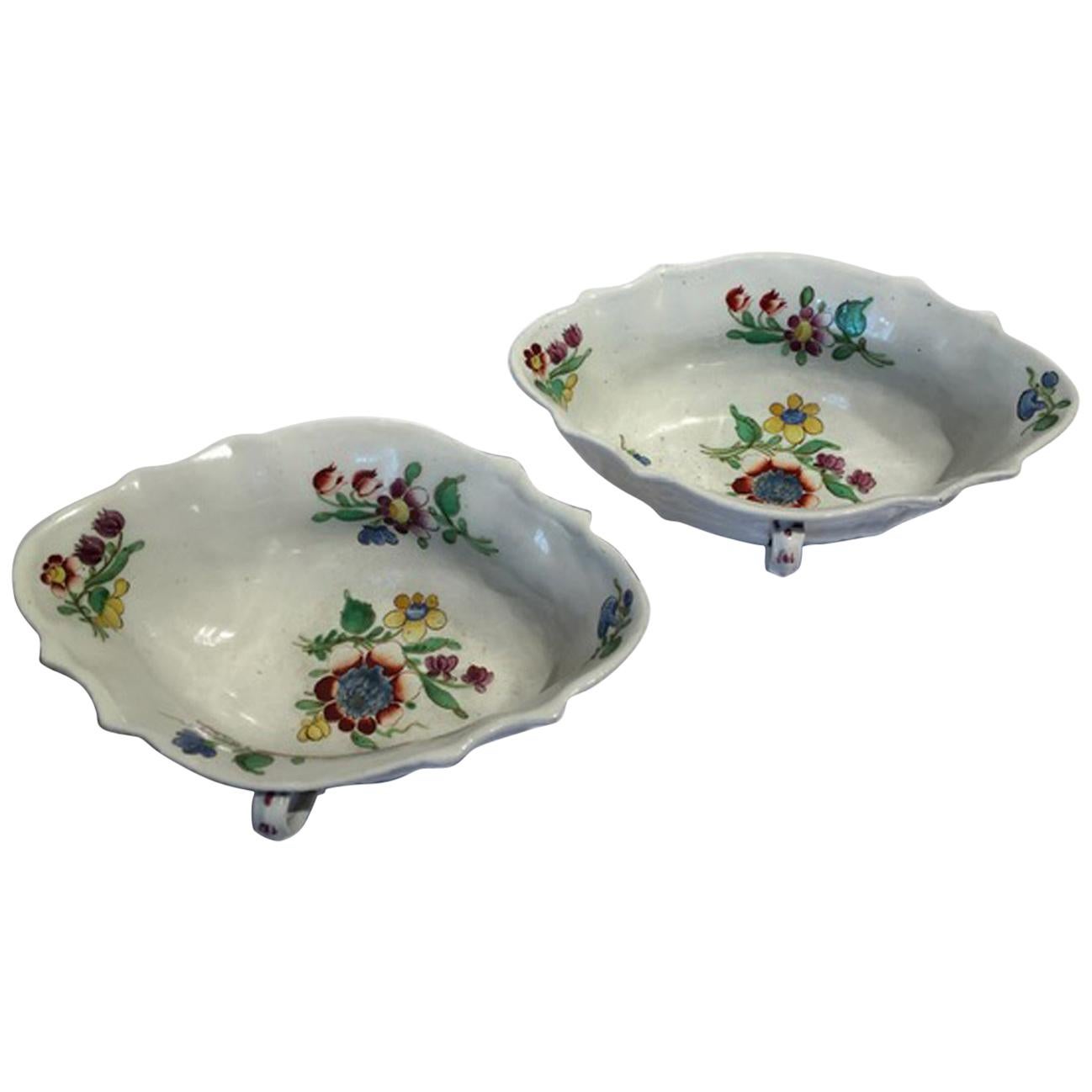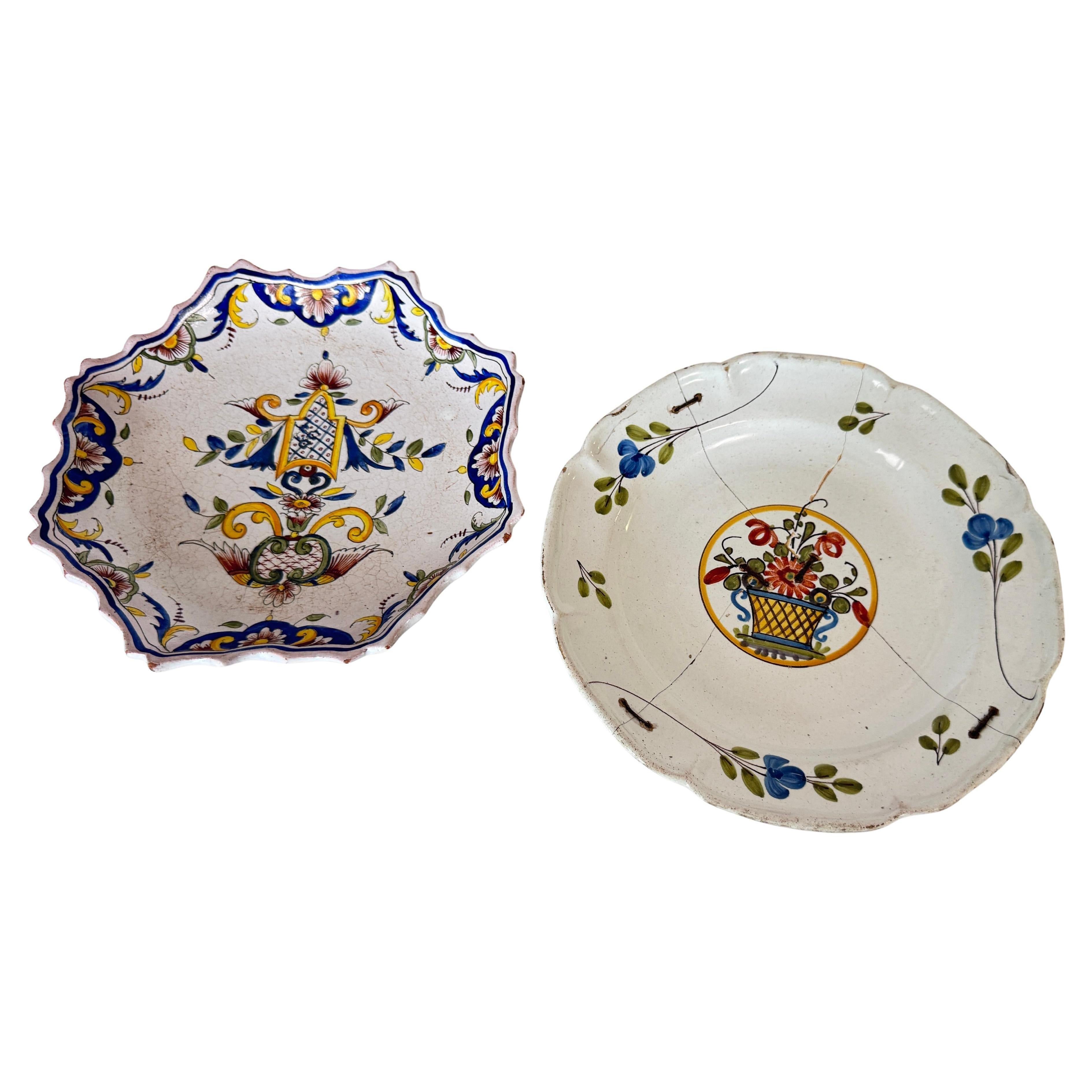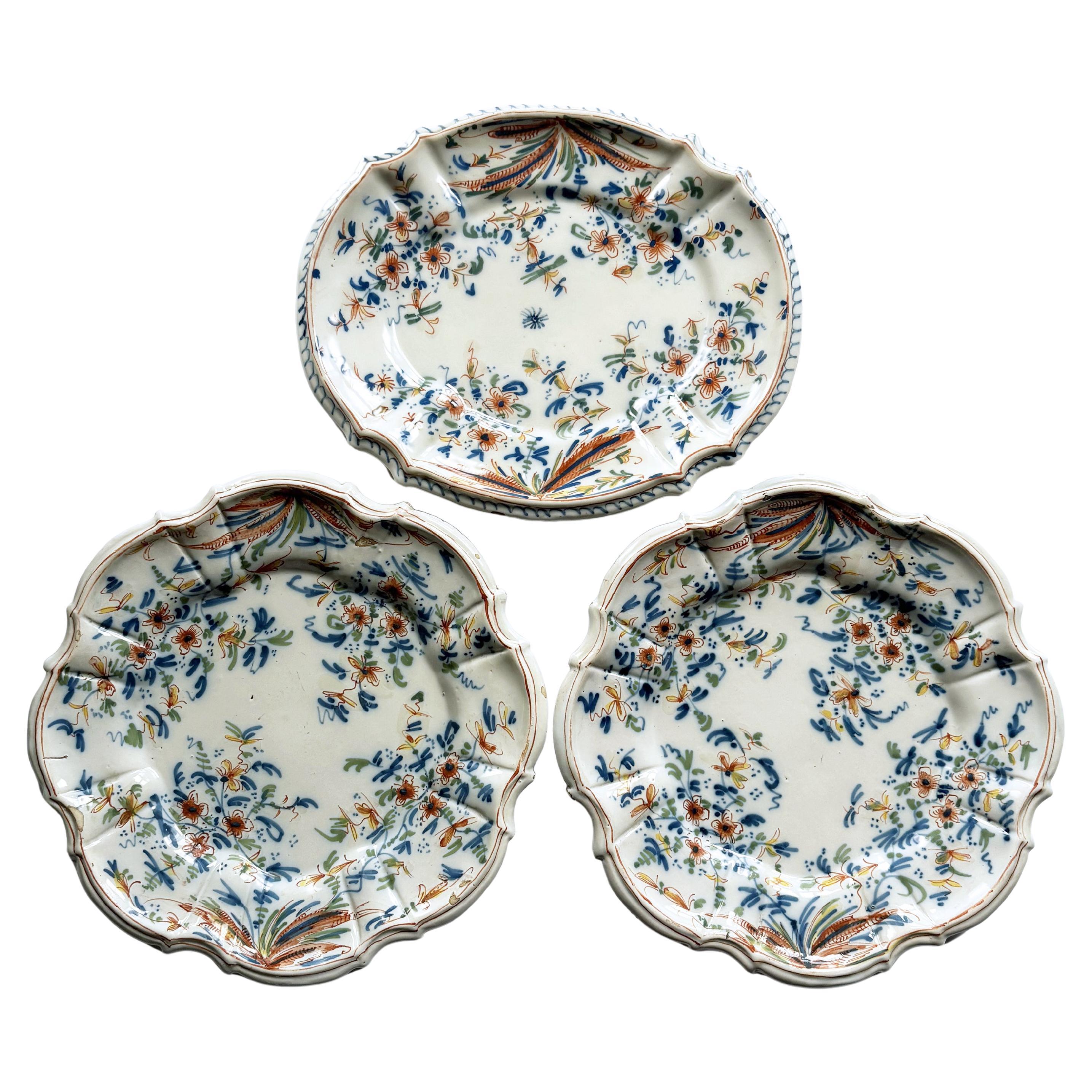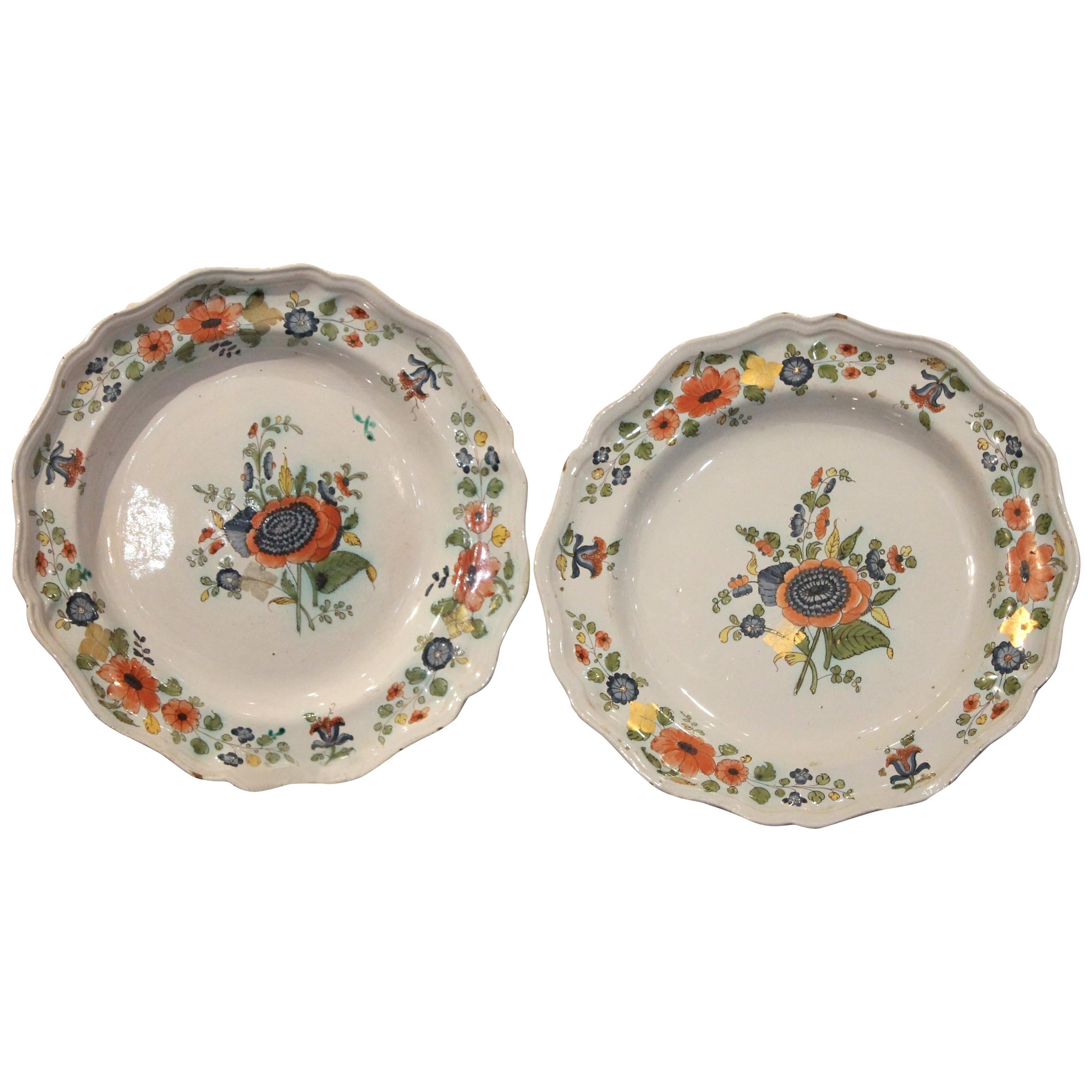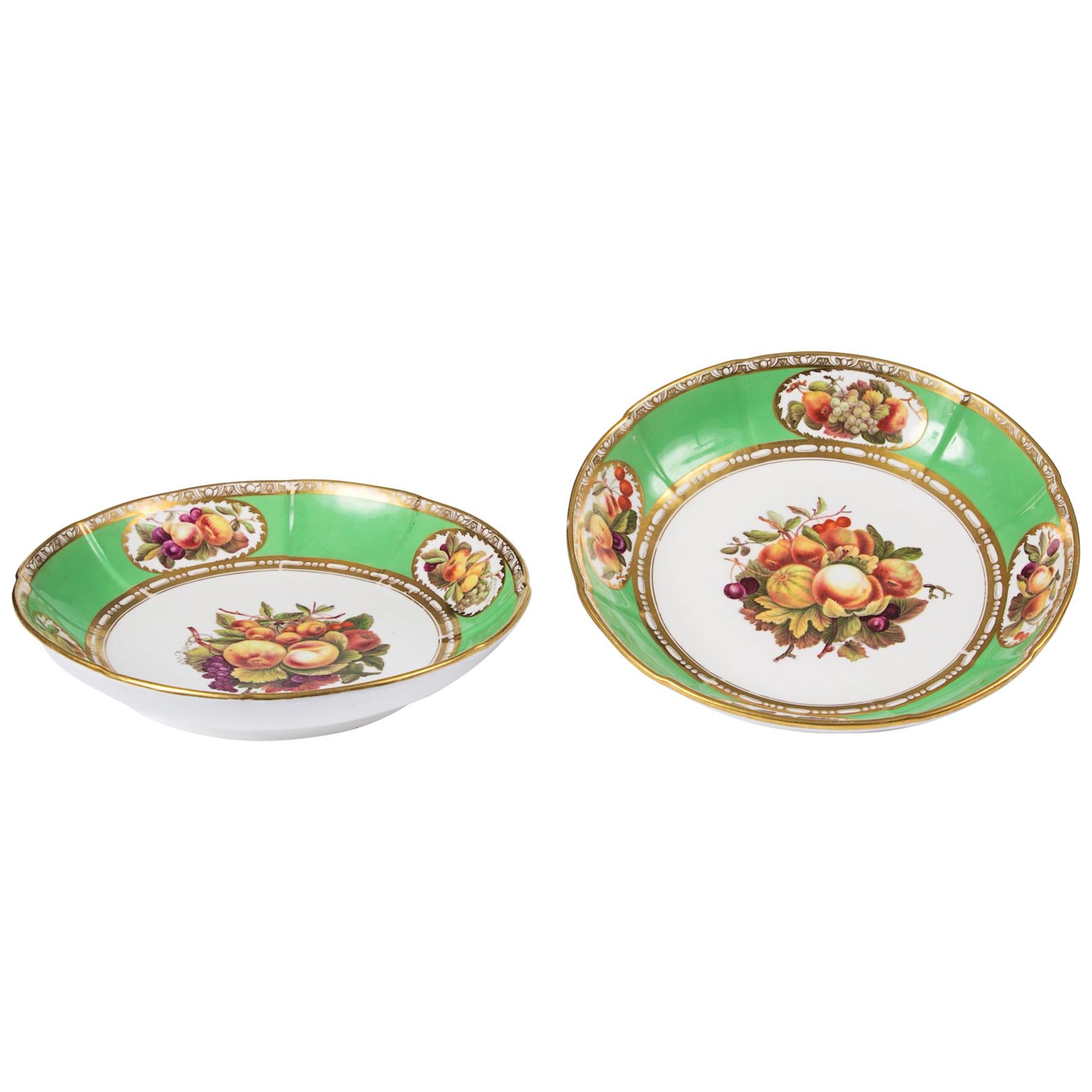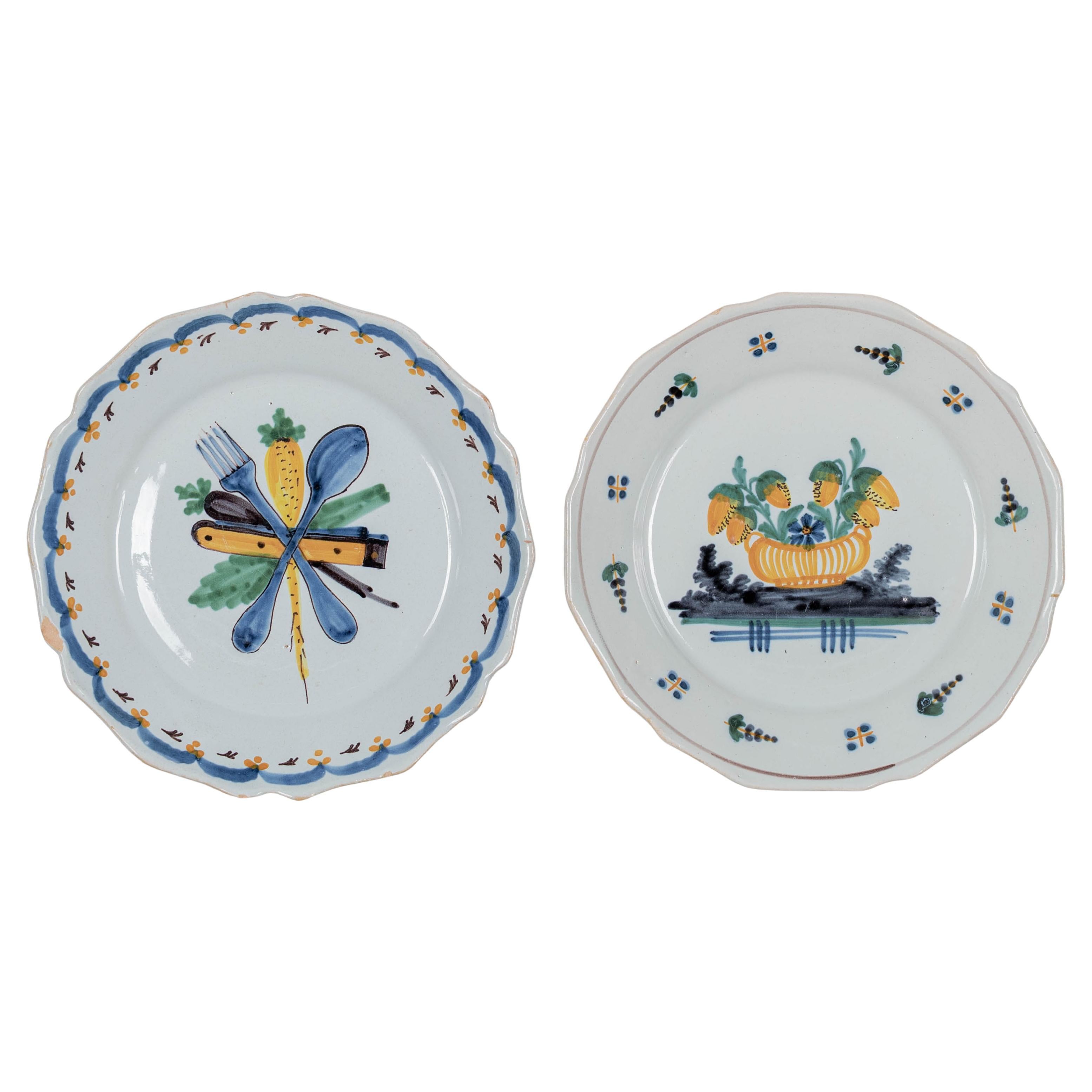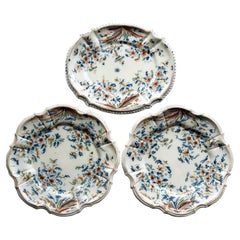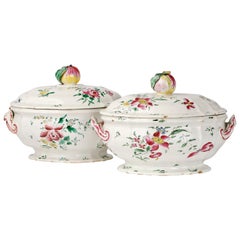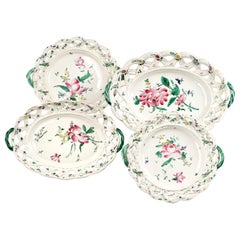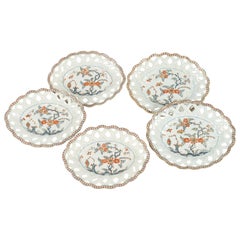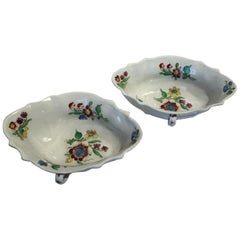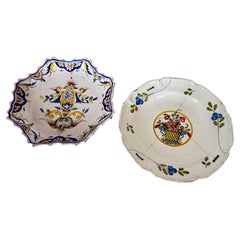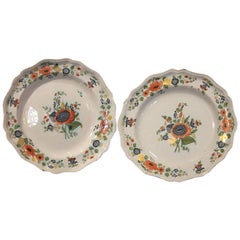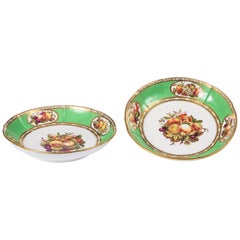Items Similar to Two Small Italian Dishes Antonio Maria Coppellotti Manufacture, Lodi, Circa 1740
Video Loading
Want more images or videos?
Request additional images or videos from the seller
1 of 18
Two Small Italian Dishes Antonio Maria Coppellotti Manufacture, Lodi, Circa 1740
$4,197.13per set
£3,122.24per set
€3,500per set
CA$5,747.30per set
A$6,390.22per set
CHF 3,336.62per set
MX$77,784.50per set
NOK 42,573.80per set
SEK 39,889.62per set
DKK 26,643.57per set
Shipping
Retrieving quote...The 1stDibs Promise:
Authenticity Guarantee,
Money-Back Guarantee,
24-Hour Cancellation
About the Item
Two small dishes
Antonio Maria Coppellotti Manufacture
Lodi, Circa 1740
High fire polychrome majolica
They measure: diameter 7.08 in(18 cm)
Weight: 0.37 lb (170 g)
State of conservation: one is intact, with only minor chips along the edges and a thin fêlure; the second one is broken into three pieces with visible restoration on the back.
The pair of small plates features a traditional form without a support ring, with a short, slightly inclined, and mixed-line profile. The rim is undulating, scalloped, and bordered in brownish-brown.
The high-fire polychromy decoration is executed over a thick, cream-white enamel in the first one and slightly darker in the other, with a few small air bubbles in both. In one specimen, positioned at the center of the composition, there is an "aerial" grassy mound upon which rests a small tree accompanied by two fruits: a plum and a peach. In the second dish, a leafy branch is painted with two small pears, and a polychromatic bird perches on it. In both dishes, the rim is decorated with the alternating pattern of flowering branches and polychromatic insects with long legs. Both of them bear the monogram "AMC" on the reverse, outlined in light green for one and brown for the other. The comparison of the "AMC" monogram confirms the attribution: reference can be made to some specimens exhibited in the Lodi exhibition of 1995. (M. L. Gelmini, Maioliche lodigiane del '700, Milan 1995, pp. 112-115; nn. 103-104).
Very close in terms of morphology and decoration, but slightly larger in size, is a dish (inventory number 325) with a similar ornamentation, now preserved in the Applied Arts collections of the Castello Sforzesco in Milan. (R. Ausenda, ed, Museums and Galleries of Milan. Museum of Applied Arts. Le ceramiche. Volume Two, Milan 2000, p. 191, n. 231).
The two small dishes are indeed certain works of the Lodi manufacture by Antonio Maria Coppellotti, adhering to all of its compositional standards. These works can be placed within the peak period when, following Baroque canons, the "fruit" decoration became one of the most requested subjects. This style was then adopted not only by nearby Lombard factories but also by the Antibon manufacture in Bassano (G. Ericani, P. Marini, N. Stringa La Ceramica degli Antonibon, Milan 1990), and further in the Marche region (G. Biscontini Ugolini, Ceramiche pesaresi dal XVIII al XX secolo 1986 pp. 41-44).
The painting expertise of the decorators from Lodi, especially in color control, set a standard: the red, sourced from now-depleted Eastern quarries and known as "Armenian bolo," was carefully managed during firing. This was achieved by applying a thin brushstroke of enamel over the sections affected by the chromatic range. This technique helped contain the "boiling" of the color during firing, resulting in remarkable outcomes where the relief and red-orange color characterize the production.
The first mention of the Coppellotti family as potters comes from archival documents which record the official request of an unknown Giovanni Coppellotti to open a majolica factory in Lodi in 1674. The factory, located near the church of St. John the Baptist. Philip seems to have been immediately quite successful. However, it was only in 1679, when the management of the factory passed to Antonio Giovanni Maria Coppellotti - the son or perhaps grandson of the original Giovanni - that the production reached the peak of success and became an example for the main Italian manufactures of the time, especially those in Veneto and Liguria. In 1728 the factory had to move outside the city walls at the behest of the authorities, who feared the possibility of fires.
The activity continued until about 1750, the year of Anton Maria's death and resumed later with his son, Bassano Coppellotti, under the guide of some other directors, among whom we note: first, G. Moroni, followed by Giulio Berinzaghi and in 1771 Pedrinazzi. Finally, in 1787 a new municipal ordinance ordered the definitive closure of the manufactory.
The maiolica produced during the initial period are characterized by the use of a thick, velvety enamel and have ornaments ranging from monochrome turquoise with Italian (ruins, castles, flowers) and French motifs ("rabeschi," ramage), to decorations in the manner of Chinese porcelain and oriental inspiration.
Of particular importance are ornaments of Baroque fruit which show the amazing relief effects produced by using the red tone called "Armenian bolus." This great variety of decorations appeared between 1735 and 1740 by which time, alongside the production of turquoise monochrome, polychromy with high fire technique was firmly established. The brand precisely identifying the majolica of this factory is rare and uses a woven "AMC" monogram. It was sometimes done in different colors and was sometimes accompanied by the names of the painters and modelers of the manufacture.
Referring bibliography:
C. Baroni, La maiolica antica di Lodi, in "Archivio storico lombardo" LVIII, 1930, pp. 448 f., 455-457;
A. Minghetti, I ceramisti italiani, Rome 1946, p. 129;
S. Levy, Maioliche settecentesche lombarde e venete, Milan 1962, pp. 15-17, tables 121-150;
G. Gregorietti Museo Poldi Pezzoli, Maioliche di Lodi, Milano e Pavia (catal.), Milan 1964, pp. 15 f., with ill;
A. Novasconi - S. Ferrari - S. Corvi, La ceramica lodigiana, Milan 1964, pp. 23, 27, 34-36, 47, ill. pp. 53-121;
O. G. C. Sciolla, Museo civico di Lodi, Bologna 1977, pp. VIII f.; tables pp. 72-76, 78;
M. L. Gelmini, Maioliche lodigiane del '700, Milan 1995, pp. 112-115; nn. 103 - 104;
R. Ausenda, a cura di, Musei e Gallerie di Milano. Museum of Applied Arts. Le ceramiche. Tomo secondo, Milan 2000, p. 191, n. 231;
Felice Ferrari, La ceramica di Lodi, Lodi 2003.
- Attributed to:Antonio Maria Coppellotti (Maker)
- Dimensions:Height: 0.71 in (1.8 cm)Diameter: 7.09 in (18 cm)
- Sold As:Set of 2
- Style:Baroque (Of the Period)
- Materials and Techniques:
- Place of Origin:
- Period:1740-1749
- Date of Manufacture:Circa 1740
- Condition:Repaired: One is intact, with only minor chips along the edges and a thin fêlure; the second one is broken into three pieces with visible restoration on the back. Wear consistent with age and use.
- Seller Location:Milano, IT
- Reference Number:1stDibs: LU4352241507052
About the Seller
4.3
Vetted Professional Seller
Every seller passes strict standards for authenticity and reliability
Established in 1860
1stDibs seller since 2018
21 sales on 1stDibs
Associations
International Confederation of Art and Antique Dealers' Associations
- ShippingRetrieving quote...Shipping from: Milano, Italy
- Return Policy
Authenticity Guarantee
In the unlikely event there’s an issue with an item’s authenticity, contact us within 1 year for a full refund. DetailsMoney-Back Guarantee
If your item is not as described, is damaged in transit, or does not arrive, contact us within 7 days for a full refund. Details24-Hour Cancellation
You have a 24-hour grace period in which to reconsider your purchase, with no questions asked.Vetted Professional Sellers
Our world-class sellers must adhere to strict standards for service and quality, maintaining the integrity of our listings.Price-Match Guarantee
If you find that a seller listed the same item for a lower price elsewhere, we’ll match it.Trusted Global Delivery
Our best-in-class carrier network provides specialized shipping options worldwide, including custom delivery.More From This Seller
View AllThree Dishes, Antonio Maria Coppellotti Factory, Lodi, Italy, Circa 1745
By Antonio Maria Coppellotti
Located in Milano, IT
Pair of round dishes and a small oval tray
Antonio Maria Coppellotti factory
Lodi, circa 1745
High fire polychrome majolica
Dishes size: diameter 9.44 in, height 0.78 in (24 cm, 2 c...
Category
Antique 1740s Italian Rococo Delft and Faience
Materials
Maiolica
Pair of Italian Maiolica Tureens, Ferretti Manufacture, Lodi Circa 1770 - 1780
By Antonio Ferretti
Located in Milano, IT
Pair of maiolica tureens
Antonio Ferretti Manufacture
Lodi, circa 1770-1780
Maiolica polychrome decorated “a piccolo fuoco” (third fire).
a – 8.66 x 11.02 x 7.48 in (22 x 28 x 19...
Category
Antique 1770s Italian Rococo Ceramics
Materials
Maiolica
Four Italian Ancient Dishes, Antonio Ferretti, Lodi, circa 1770-1780
By Antonio Ferretti
Located in Milano, IT
Assortment of 4 dishes with braided rim
Antonio Ferretti Manufacture
Lodi, circa 1770-1780
Maiolica polychrome decorated “a piccolo fuoco” (third fire).
Measures: 14 x 10 in (35.5 x 25.5 cm);
12.2 x 8.39 in (31 x 21.3 cm);
10.4 x 9.65 in (26.5 x 24.5 cm);
10.8 x 9.61 in (27.5 x 24.4 cm).
Weight: 4.4 lb (1.998 kg)
State of conservation: some chips due to use on the edges and on the parts in relief.
The four different dishes have a foot with a low lip from which extends a wide, flat, slanted rim resembling a basket weave. The small handles are painted green: they resemble wickerwork in the two oval dishes and take the form of a sinuous branch in the round ones.
The third fire decoration is inspired by the naturalistic floral botanical patterns on the ceramics produced by the Hannong family in Strasbourg. Here the pattern is defined by the rapidity and subtlety of the brushstrokes and the result is particularly tasteful, characterized by compositional intelligence and pictorial expertise.
A main corolla, either a wild or garden rose, is set slightly off center in each well. From this extends a thin stem holding a small secondary bud and there are small field florets dotting the composition to lend volume to the delicate bunch of flowers.
On the brim, small polychrome flowers add color to the weave, accompanied by lanceolate leaves of a very intense green.
There exist few and very rare examples for comparison with this morphology: a round plate - entirely consistent with those in question - has been dated to around 1775 (S. Levy, Maioliche settecentesche lombarde e venete, Milano 1962, tav. 200). Two other dishes with a basket rim, but with parallel striped brim decoration, were exhibited in the 1995 exhibition on Lodi ceramics; the attribution to the Lombard town near Milan is therefore almost exclusively derived from the decoration called "alla rosa contornata" or "alla vecchia Lodi" and constitutes one of the most popular decorations during the eighteenth century. (M. L. Gelmini, in Maioliche lodigiane del '700 (cat. mostra Lodi), Milano 1995, pp. 31 p. 162-163 nn. 181-182).
This decorative choice represented a strong point of the Lodi factory, which established itself thanks to the vivid nature of the colors made possible by the introduction of a new technique perfected by Paul Hannong in Strasbourg and which Antonio Ferretti introduced in Italy. This production process, called “piccolo fuoco” (third fire), allowed the use of a greater number of colors than in the past; in particular, the purple of Cassius, a red made from gold chloride, was introduced. Its use allowed for many more tones and shades, from pink to purple.
The Ferretti family had started their Maiolica manufacturing business in Lodi in 1725.
The forefather Simpliciano had started the business by purchasing an ancient furnace in 1725 and, indeed, we have evidence of the full activity of the furnaces from April of the same year (Novasconi-Ferrari-Corvi, 1964, p. 26 n. 4). Simpliciano had started a production of excellence also thanks to the ownership of clay quarries in Stradella, not far from Pavia. The production was so successful that in 1726 a decree of the Turin Chamber came to prohibit the importation of foreign ceramics, especially from Lodi, to protect internal production (G. Lise, La ceramica a Lodi, Lodi 1981, p. 59).
In its initial stages, the manufacture produced maolicas painted with the “a gran fuoco” (double fire) technique, often in turquoise monochrome, with ornamentation derived from compositional modules in vogue in Rouen in France. This was also thanks to the collaboration of painters like Giorgio Giacinto Rossetti, who placed his name on the best specimens next to the initials of the factory.
In 1748 Simpliciano made his will (Gelmini, 1995, p. 30) appointing his son Giuseppe Antonio (known as Antonio) as universal heir. After 1750, when Simpliciano passed away, Antonio was directly involved in the Maiolica factory, increasing its fortunes and achieving a reputation on a European level. Particularly important was the aforementioned introduction in 1760 of the innovative “a piccolo fuoco” (third fire) processing, which, expanding the ornamental repertoire with Saxon-inspired floral themes, could commercially compete with the German porcelains that had one of its most renowned offerings in the naturalistic Deutsche Blumen. Antonio Ferretti understood and promoted this technique and this decoration, proposing it in a fresher and more corrective version, less linked to botanical tables...
Category
Antique 1770s Italian Neoclassical Ceramics
Materials
Maiolica
Ancient Maiolica Plates Pasquale Rubati, Milan Circa 1770-1780
By Pasquale Rubati
Located in Milano, IT
Five oval maiolica dishes with pierced edge
Manufacture of Pasquale Rubati
Milan, 1770-1780
Three small oval dishes 10.23 in x 7.67 in (26 cm x 19.5 cm)
Two large oval dishes 10.82 in x 8.85 in (27.5 x 22.5 cm)
lb 3.5 (kg 1.8)
State of conservation: intact
The five dishes of different sizes have an oval shape, a mixtilinear edge and a molded polylobed shape with a surface enriched with a relief weave motif extending to the brim and forming a perforated basket...
Category
Antique 1770s Italian Rococo Ceramics
Materials
Maiolica
Ancient Maiolica Dishes with flowers, Lombard Manufacture, 1770-1780 Circa
Located in Milano, IT
Assortment of dishes
Lombard manufacture
1770 – 1780 Circa
Maiolica polychrome decorated “a piccolo fuoco” (third fire).
Two large dishes: diameter 14.76 in (37.5 cm); weight 4.5...
Category
Antique 1770s Italian Rococo Ceramics
Materials
Maiolica
Italian Maiolica Cup Ferretti Lodi, circa 1770 - 1780
By Antonio Ferretti
Located in Milano, IT
Maiolica puerperal cup
Antonio Ferretti Manufacture
Lodi, Circa 1770 - 1780
Maiolica polychrome decorated “a piccolo fuoco” (third fire).
It measures: 4.3 x 6.8 x 5.3 in (11 x 17,5 x 13,5 cm)
Weight: 0.78 lb (358 g)
State of conservation: some closed pass-through fêlures on the cup, barely visible on the outside. Some use chips on the edge of the lid, two of which are more marked.
From about the mid-sixteenth century, the puerperal soup tureen or puerperal cup became one of the most popular wedding gifts in central Italy. As an auspicious symbol, it replaced the birth table (“desco da parto”) which, on the occasion of high-ranking marriages, from the thirteenth century, had been painted by famous artists, especially in Tuscany.
In France this same tureen is called "écuelle de mariée", as it is given to spouses as a sign of fertility.
During the eighteenth century this custom spread even outside Italy to all social levels. Depending on availability and rank, it was made of different materials: precious metals, maiolica, porcelain, glass, pewter, etc.
Beginning in the mid-twentieth century, the custom of this symbolic homage gradually disappeared, although famous designers such as Gio Ponti and Giuseppe Gariboldi, even as recently as the 1940s, revisited a model of a small puerperal soup bowl for the Ginori and, also in Italy in 1940, in a national competition for young potters, one of the themes of the test was indeed a modern model of a puerperal cup as an auspicious gift.
This particular cup was also called a "service cup" or "puerperal vase" or "stuffed cup" - the windows were sealed with straw to prevent drafts of air for women in labor.
In the eighteenth century the line of the puerpera cup was simplified, so much so that it took the form of a small tureen with two handles - the typical broth cup...
Category
Antique 1770s Italian Rococo Ceramics
Materials
Maiolica
You May Also Like
Italy 18th Century Italy Richard Ginori Doccia Pair of Porcelain Sauce Bowls
By Richard Ginori
Located in Brescia, IT
This is an elegant pair of porcelain sauce bowls with floral drawings in red and blue.
It is beautiful for a table dressing or to collect.
The production of this well known Italian...
Category
Antique Mid-18th Century Italian Baroque Porcelain
Materials
Porcelain
$1,822 Sale Price / set
20% Off
Pair of 19th-Century French Faience Plates – Hand-Painted Rouen Style
Located in Auribeau sur Siagne, FR
Pair of 19th-Century French Faience Plates – Hand-Painted Rouen Style – Blue, Yellow & Rust Tones – Authentic Antique
Description:
This is a pair of antique French faience plates, d...
Category
Antique 19th Century French French Provincial Delft and Faience
Materials
Faience
Pair of 18th Century Hand Painted Multi-Color Porcelain Decorative Dinner Plates
By Meissen Porcelain
Located in Firenze, IT
These two beautiful and antique hand painted multi-colored porcelain dishes date back to 1700.
Each plate has shaped rims with molded and trimmed relief, the white porcelain backgro...
Category
Antique 18th Century German Rococo Dinner Plates
Materials
Porcelain
Early 19th Century Regency Spode Pair of Porcelain Dessert Dishes
By Spode
Located in Dublin 8, IE
Early 19th century Regency Spode pair of porcelain hand painted dessert dishes of circular form with lobed gilded rim, decorated to the edge with gilded egg and dart motif against gr...
Category
Antique 1810s British Regency Serving Pieces
Materials
Porcelain
18th Century French Faience Plates Set of 2
Located in Winter Park, FL
A set of two 18th century French faience plates with primitive hand painted decoration. Minor chips and glaze losses on edges of scalloped rim. No hairline cracks or restorations not...
Category
Antique Late 18th Century French Provincial Delft and Faience
Materials
Faience
Pair of Plates decorated by Jefferyes Hamett O'Neale, Chelsea, circa 1755
By Chelsea Porcelain
Located in Melbourne, Victoria
A pair of plates in ‘Warren Hastings’ shape, with fine rococo moulding, decorated by Jefferyes Hamett O'Neale with geese and other birds to the reserve...
Category
Antique Mid-18th Century English Rococo Porcelain
Materials
Porcelain
More Ways To Browse
L M Silver
Broken Ceramics
Italian Lombard
Italian Bird Plate
Antique Ring Tree
Antique Silver Cat
Red Glass Dishes
Glass Dish Orange
Antique Italian Porcelain Flowers
Monogram China
Orange Glass Birds
Chinese Reverse Glass Paintings
Antique Monogram Ring
Silver Rim Set Of China Plates
Antique French Porcelain Dishes
Antique Ring Dish
Silver Bird Ring
P M Porcelain
